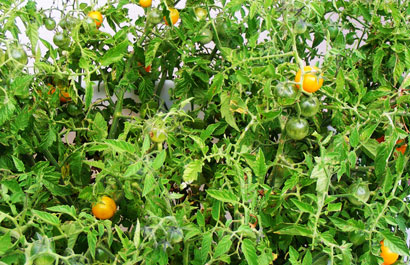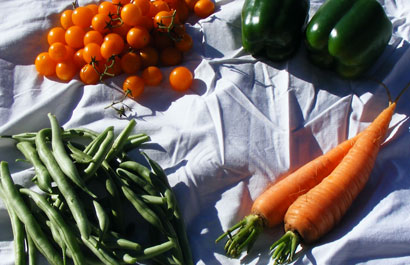Our goal is to have More Food with Less Work!
I plant all my food in SIPs (Sub-Irrigated Planters) in 100% compost. Once I prepare a SIP my work is greatly simplified. I spend just a few minutes a day watering and weeding.
If we are to produce enough food for our families and to share with others, we must cooperate with God's plans for food production. It's great to be able to go to the store and purchase food, but that source can diminish at any time due to circumstances beyond our control, or it may become too expensive. No matter where you live, in the country or in a bustling city, "tend the garden" and grow as much food as you can.
Let’s divide the process of food production into key areas: Soil, Water, and Gardening Techniques.
SOIL
If you build good soil, plants grow strong enough to protect themselves from many insects and diseases. Yields will greatly increase when plants are rooted in good soil.
COMPOSTING
Composting is a great gift from God. It allows us to rebuild and replenish soil while managing waste that that could cause poor sanitation and sickness. When waste is carefully composted and placed on or mixed with existing soil, the same piece do land can be used year after year and actually become more productive with the passing of time.
Consider using Homemade Liquid Fertilizers to supplement compost.
See Homemade liquid fertilizers
WATER
Where I live water is scarce. I have spent years learning ways to get the greatest amount of food with as little water as possible. In many countries there is plentiful rain, but water systems are not available to bring water where it is needed. Often water is carried by hand to homes and gardens, sometimes miles from the water source. Here are some ideas that will maximize the water that you have.
. Use containers for gardening. Containers allow great control
of water.
. Use Sub-Irrigated Planters.
. Control evaporation by using a greenhouse, row covers or mulches (or all three).
. Use polymers. Polymers for gardening are mixed with garden soil. They expand with moisture and hold water in the root zone.
. Use drip systems.
. Choose drought-resistant plants that produce more food
with less water.
. Use fast-growing plant varieties.
. Apply water in measured amounts by hand. This has proven to be the most efficient way to get the most food with the least amount
of water.
. Use biochar (charcoal) to hold moisture in the root zone.
. Use plenty of compost. Compost holds more water than poor soils.
. Use gray water for gardening. This must be done with great care.
(See Gray Water, pp. )
. Develop rainwater catchment to secure water and contain it until it is needed in the garden. (See Rainwater Catchment for DRYLANDS and Beyond by Brad Lancaster.)
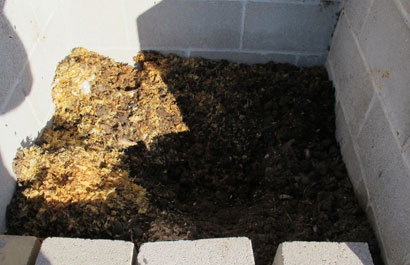
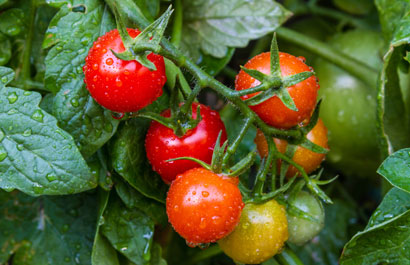
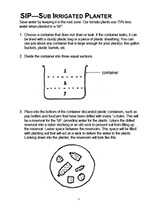
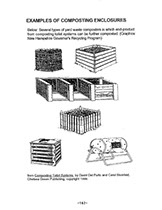
SIP SYSTEM pdf
Composting pdf
Note: The basic organic methods suggested in ABUNDACULTURE will reduce water needs by 67-88% according to research done by John Jeavons. (See the Internet for a complete listing of John Jeavons' work.)
1) Choose a container that does not leak. If the container leaks, it can be lined with a sturdy plastic bag or a piece of plastic sheathing. You can use just about any container that is large enough for your plant(s): five gallon buckets, plastic barrels, etc. Translucent 30 or 55 gallon plastic barrels are my favorite containers. They let in light and they are very sturdy. I buy used barrels for $10-25. They are typically used for soaps or food products. I avoid containers that held harsh chemicals.
2) Place into the bottom of the container, discarded plastic containers such as pop bottles and food jars. Plastic containers can be drilled with holes to allow water to fill the void. Even wide-mouth glass jars placed on their sides will work as reservoirs. These reservoirs will hold water for plants. After you've drilled holes in the reservoirs, they need to be placed in an old nylon stocking or a piece of cloth. This allows water into the reservoir, but not soil.
The reservoirs are placed in the bottom of the SIPs. They will create a void that will be 4" to 6" deep.
3) Drill two 3/4 inch holes in the SIP just above the depth of the reservoir created by containers wrapped to prevent filling with soil. These holes are called weep holes. They allow excess water to leave the container so that plants cannot drown. Make sure that you will be able to see the weep holes when the SIP is in place.
4) Place a fill-tube in the planter. Put it well away from the weep holes. You can use a tall plastic container or a piece of plastic pipe for the fill-tube. Drill holes in the bottom 6" of the fill-tube. Cover the holes with a nylon stocking or a piece of cloth so that the fill-tube won't become filled with soil. Hold the cloth or stocking in place with duct tape. Large pipe (2"-4") is easy to fill.
5) Fill the planter carefully with lightweight, fluffy potting soil or compost. I often use horse, cow, chicken or sheep manure mixed about 50/50 with sawdust or fine woodchips and composted for at least one year. For another option, see Mel Bartholemew's SQUARE FOOT GARDENING. Put the SIP where you want it. Once it is filled with soil and water it will be very heavy and difficult to move.
6) Add water slowly through the fill tube. Fill only until water starts to come out of the weep hole. Do not overfill. Because you are using a SIP, you will need much less water, perhaps 50-75% less water. Less water will be lost to evaporation. After your plants are established, you may choose to cover the exposed soil with mulch to further discourage evaporation. You may need to keep the topsoil moist while your seeds are germinating or if the weather is particularly hot and windy.
Advantages of the SIP Planter
1) It uses less water.
2) Soil nutrients are not washed away.
3) Soil amendments and plant supplements can be customized to each SIP.
4) If you use a translucent barrel with a lid for your SIP, you can protect young plants from wind, hail and frost.

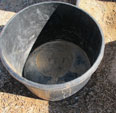
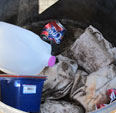
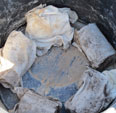
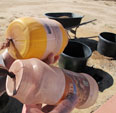
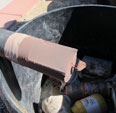
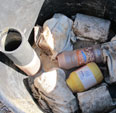
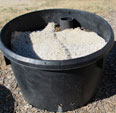
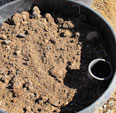
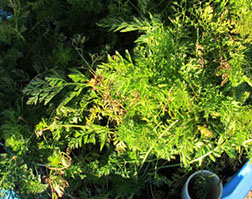
Note: Every gardener will develop his own methods for success. The following are some of my favorite techniques.

Start small and grow as needed. A well-maintained small garden can produce more food than a larger, poorly maintained space. A huge garden can be overwhelming and discouraging. It is not uncommon to produce 300-500 pounds of food in a 10'X10' space.
. Use vertical space for plants. Pole beans, peas and tomatoes are good candidates for vertical growth.
. Use containers for gardening. Containers allow great control of water, space and soil amendments.
. Eat as much food as possible fresh from the garden. Preserve foods as needed by drying, canning or pickling.
. Extend the growing season. Use strategies to plant earlier and harvest later.
A. Use double-covering methods in cold climates. This means to provide at least two coverings to protect plants from cold.
EXAMPLE: Plants covered by a greenhouse are also
covered by cloth.
B. Store water in the greenhouse to moderate temperature.
C. Use a heat source in the greenhouse if absolutely necessary.
. Diversify your garden biosphere. Plant many types of vegetation. Raise bees.
. Allow for failure of certain crops. Diversify plantings so that the failure of one crop is covered by a crop that succeeds.
. Avoid using harsh chemicals for pest control. Allow for some losses and go to the Internet for easy-to-make organic pest control solutions.
. Use fencing to control predators and wind.
. Choose garden crops carefully. Plant only what you can eat or trade. Take care of your family's needs first.
. Hybrids can greatly increase yields. Use open-pollinated and heritage seeds to facilitate seed saving.
. Rotate crops to prevent disease and make the most of soil nutrients.
. Rest your garden every seventh year.
. Weeds are easy to control if you are diligent. Pick weeds when they are small, before seeds are present. Non-invasive, immature weeds can be composted.
. Make gardening a community project. The relationships that grow are even more important than food. Gardening with friends is fun!
THIS IS IMPORTANT! Plan on spending at least ten minutes every morning and evening carefully inspecting your garden. Many problems can be avoided this way. If you are going to spend most of the growing season away from your garden, save yourself the aggravation and forget the garden.
